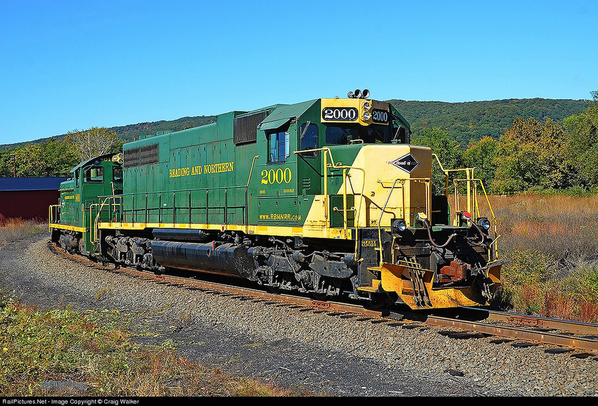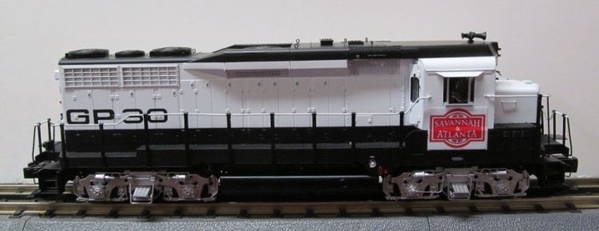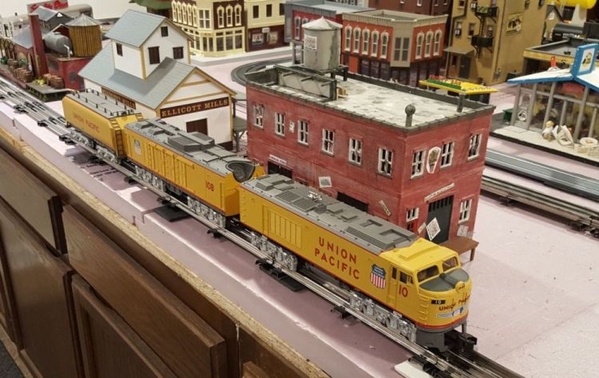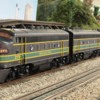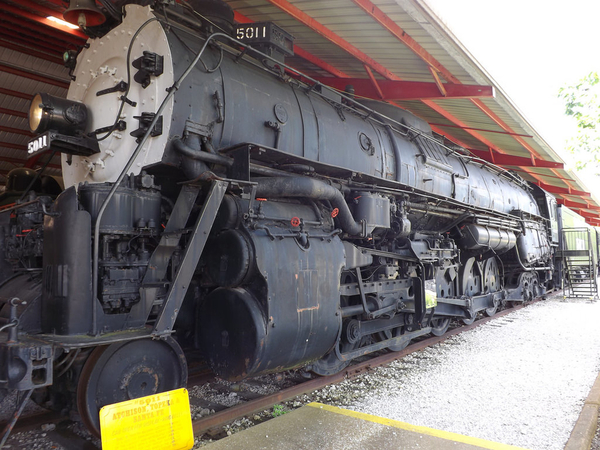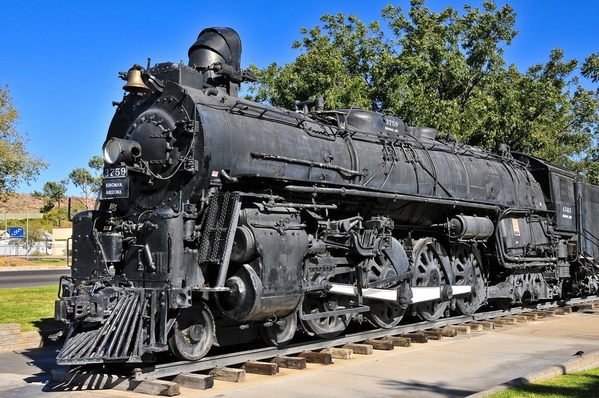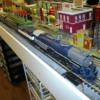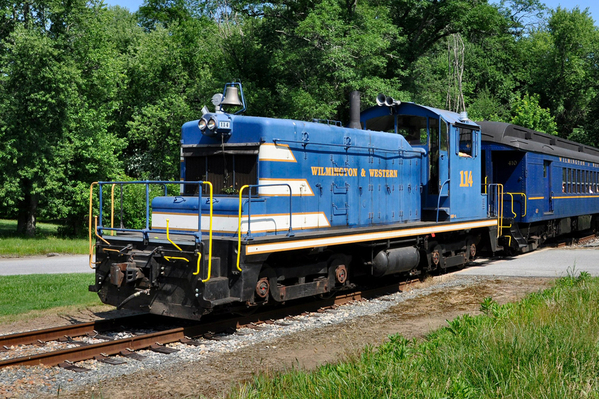Between museums and running live, I have seen the prototype of all of my locomotives except for the Dreyfuss Hudson and the Pennsy steam turbine.
Two, more or less.
1st, I have seen the L3 Mohawk in the NMOT in St. Louis, which is sorta the prototype for my T&P #907. I have only seen pics of the actual T&P paint job on the real Mohawk used by the Texans.
2nd, I have seen the prototype #41 Army switcher, also in the NMOT. The PW model is surprisingly accurate.
Yes, Boston & Maine Mogul #1455. I saw it at the Edaville RR in So Carver, Ma, but it is currently located at the Danbury, CT, RR museum.
It's a good question.
My family lived on the PRR main line when I was a kid in 1952, so I saw pretty much everything the PRR put on rails during that period. In the beginning, there were a lot of Decapods, M1s and K4s, mixed with a growing number of F3s, particularly in passenger service.
As time went on and the PRR dieselized, it was various flavors of Geeps (including the odd GP B-units) and whatever else the PRR had that was EMD MU-compatible. Baldwin Sharks were fairly common.
I don't recall seeing much from Fairbanks-Morse, though that may be because as a young kid, I hadn't yet learned to identify them.
When the Northumberland yard was still active, I saw B6b switchers in action. There was also a switch yard in my then-hometown of Huntingdon, PA, but it was served by EMD diesel switchers (sorry, I can't recall which model numbers).
My parents were from Eastern Pennsylvania, so when we visited my grandparents, I used to see a lot of Reading equipment. Sadly, I don't remember seeing any RDG steam. And on occasional drives to the Harrisburg area, I'd see GG1s under wire. Once, we stopped at a restaurant next to a PRR electrified section, and I was fascinated to watch the GG1s running past.
With all this PRR background, you'd think I'd have a lot of PRR models, but I don't. A pair of Williams Sharks, a Lionel B6b, and that's about it. Also a RDG T-1 and RDG FM Train Master, both by Lionel. But most of my model equipment is for the NYC, a road that I never actually saw in action. I have no idea why.
I got to actually ride in a GG1 a few times. My dad was an engineer for the PRR and back in the early 50 s every now and again he would take my older brother or I with him on a trip. He worked out of Sunnyside Yards in Queens NY. We got to sit on his lap as he took a passenger train from Sunnyside to Penn Station and then back out to various destinations.
I vividly remember my first trip. It scared the you know what out of me when the train took off out of the yards. It is so noisy and to my 5 year old mind it swayed terribly from side to side before speeding up. I thought it was going to fall over.
Of coarse times were very different in those days. I often wonder if any of today's engineers ever take their kid up in the cab with them.
Ed
I have seen the N&W A, J, Y6 and K2 while they were in service in the fifties.
Yes, in museums though - specifically the Illinois Railway Museum: trolleys, older steam, http://www5.irm.org/roster/index.html
The only one that immediately comes to mind is my MTH P&LE GP7 no. 1501.
I attended college in Coraopolis, PA; up the Ohio River from Pittsburgh and located on the P&LE mainline. I had an apartment in Ambridge, PA and would make the drive to school every morning, at least part of the way along the P&LE tracks.
P&LE was still running a commuter train from College, PA to the P&LE station across the Mon River from downtown Pittsburgh and 1501 was one of the engines regularly assigned to this commuter train; 1500 bring the other.
The inbound commuter train would pass me about two or three days each week depending on how early my first class was and I can remember 1501 specifically because it was painted in a bicentennial scheme.
My model doesn’t carry this bicentennial scheme but, it does match 1501’s next paint scheme which was the black and yellow with large P&LE letters on the long hood.
Curt
In 1957, my father bought me the Lionel 628 Northern Pacific 44 ton switcher (and Super O track) because my starter set steamer had worn out. I ran that switcher almost non-stop until my teenage years when I put my trains away.
Then, somewhere around 1985, I was vacationing in Pennsylvania with my wife and kids when I saw the real thing! My reaction was that it was stubby compared to the Lionel version. For once (that I could recall) Lionel elongated their version of the actual prototype. Usually, they compressed the real dimensions so that their version could negotiate 027 and 031 curves. But, in this case, they made the model longer.
John
GG1 numerous times, Nickel Plate 765 rode and crewed in the 80's; Pennsy I1a involved in the WABCO to Hamburg NY move in the 80's.;
N&W J rode behind it 1980s
Attachments
Ever since I was 2 years old up until they were scrapped in the early 1980's, I rode trains pulled by the PRR GG-1 electric locomotives from Washington DC to Penn Station, New York. two of my GG-1's are shown below:
Though I never rode behind this locomotive, I saw it in action many times while growing up in the Baltimore area.
Even though I was born too late to remember seeing these in revenue service, thanks to the Railroad Museum of Pennsylvania, I have seen the prototypes of the following locomotives represented in the ensuing photos by my models. The PRR K4-s:
The PRR M1-A:
Attachments
I have the Lionel version of this one as well:
And run it all the time - the Lionel version, that is ![]() .
.
Alex
Attachments
John, I think Lionel's 44 tonner is larger than scale because they used the GP7, Budd car, etc frame to save money. I'm sure one of the postwar experts out there can "shed some light" on my opinion.
Attachments
Attachments
I bought this one from a forum member because I had seen the real one at the Illinois Railroad Museum.
Attachments
Steam Crazy posted:John, I think Lionel's 44 tonner is larger than scale because they used the GP7, Budd car, etc frame to save money. I'm sure one of the postwar experts out there can "shed some light" on my opinion.
Steam Crazy:
You are probably right. Rather than design a smaller frame, they used the same frame from previous models. Then they designed a shell that resembled the 44 tonner to fit the existing frame.
Thanks,
John
Yes I have a mth csx sd70ace locomotive.I have seen a few on the local trains.One had a good size train by it self at least 40 t0 50 cars.Of course the steam 611 and nctm 604.I have a williams conrail dash 8.Seen a few on csx and ns.
Canadian National version of the Turbo Train, both in black white and red, and in VIA blue and yellow. I have the latter from MTH.
Bruce
The MTH GE/Alco/Ingersole-Rand diesel. Back in the 40s it ran in a small waterfront in the Bronx. We'd pass on way between NJ and Long Island.
Steamcrazy wrote:
John, I think Lionel's 44 tonner is larger than scale because they used the GP7, Budd car, etc frame to save money. I'm sure one of the postwar experts out there can "shed some light" on my opinion.
Actually, the original shell and frame are unique to the Lionel 44 tonner. What is NOT unique is everything else! Lionel used the existing tooling for the motor, side frames and e-unit and designed the shell and frame to fit them. They were looking for something different that could be made with as little additional expense as possible. From a scale point of view, the result is much closer to a GE 100 ton switcher.
Chris
LVHR
I have ridden, ran and worked with many GG1s during my 13 years as a Conductor out of NYC Penn Station. I hired on the Penn Central, July 1974.
Ponz
Attachments




Attachments
Actually, the original shell and frame are unique to the Lionel 44 tonner. What is NOT unique is everything else! Lionel used the existing tooling for the motor, side frames and e-unit and designed the shell and frame to fit them. They were looking for something different that could be made with as little additional expense as possible. From a scale point of view, the result is much closer to a GE 100 ton switcher.
The motor truck and collector truck were unique to the Lionel 44 ton locomotive. While they look similar to postwar Lionel Geep trucks at first glance, the construction is quite different.
Right at the beginning of the Modern era, MPC redesigned the Geep truck to be similar to the 44 ton truck.
RGS 7
Thomas the Tank Engine (LOL)
SP 4294
SDIV 702
One that I overlooked: B&O RF16 sharknose. I have the Weaver A-B model. One Sunday while riding with my father we saw an AB pusher on an ore drag headed to Akron. My father accomodated me by following it all the way to Akron along Riverview Road.
Lou N
UP 844 FEF-3, N&W 611 J Class, Thomas the Tank Engine. Planning to see UP 4014 Big Boy next year.
Yes, indeed. When I was a young lad in St Louis I used to be taken to the Frisco tracks and see the Meteor go by. This was in pre-diesel days. I own an MTH Frisco 4501 which is a very nice locomotive even if it is actually a Santa Fe 3751 type painted Frisco blue and white. So here are some photos of the MTH Frisco 4501.
Lew Schneider
Attachments
Not only have I seen the 307L in real life, but I ran it at 90 MPH on a San Diegan. It was an outstanding locomotive.
Attachments
that had to be an awesome experience Tom !! ![]()

Attachments
ELVISP:
Very cool! You have an almost exact copy of the real thing. Nice!
John
Attachments
Here is a sample, the Lionel 600 MKT's prototype. I do try to match my locos with the prototypes.





